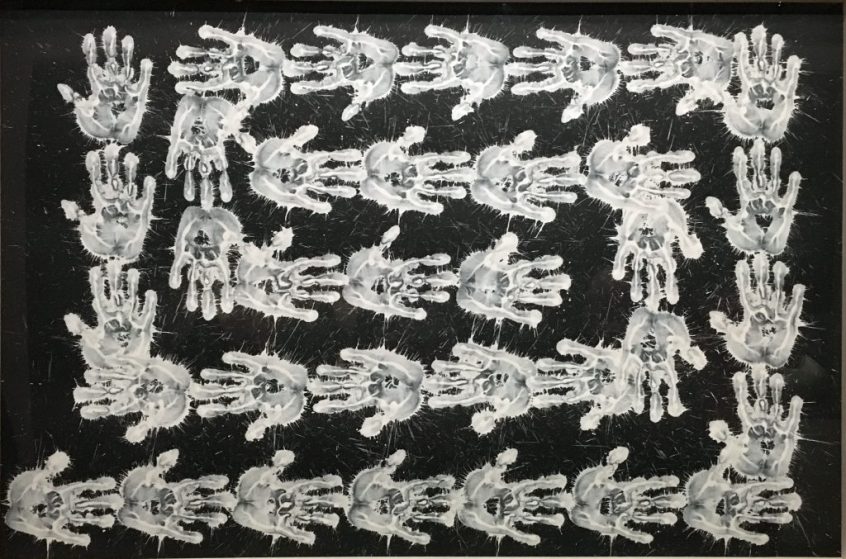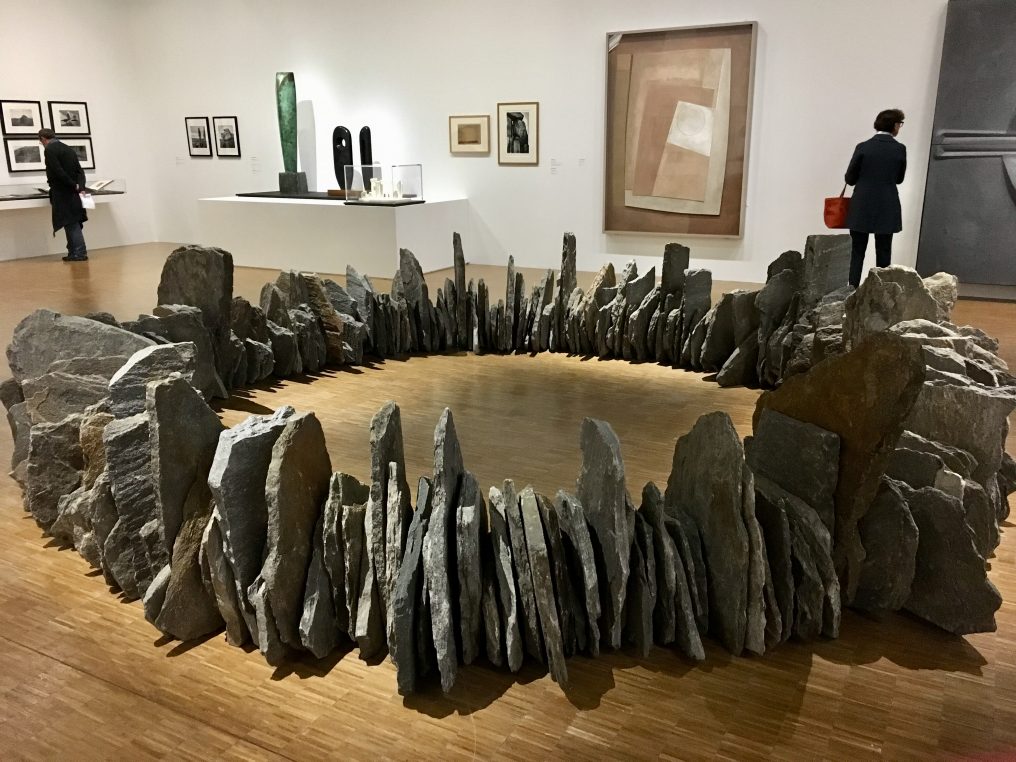I am not such a great fan of prehistory but so many finds have been made recently that I was curious to see what Centre Pompidou was going to show under the title, “Prehistory, a modern enigma“. Artists have played, along with scientists, a great role in our perception of the understanding of our origins. In the mid 19th century, stratigraphy enabled the world to understand the “epochs of nature” through the layers of the universe, as Buffon wrote. The association of painters like Cézanne and archaeologist and geologist Antoine-Fortuné Marion on the Sainte Victoire mountain near Aix enProvence, fed the imagination of painters. More recently Richard Long has been a great perpetrator of the Neolithic eras. Don’t be intimidated by the theme, the show is full off fabulous surprises including Miquel Barcelo‘s stained glass mud paintings and Robert Smithson’s film of the making of the “Spiral Jetty” near Salt Lake city.
The first rooms are devoted to the discovery of prehistory and the origins of the earth. From Paleolithic (the era of hunters and gatherers) to Neolithic (the polishing of stones) symbolized by dolmens and menhirs, 19 th century artists were fascinated by the origins of the earth and of mankind. During this period, fossils started to be analyzed, the earth’s layers were readable and caves were explored. Tools and the art that resulted from their use fascinated artists in general.
Picasso, Miró, Klee, Ernst, Klein, Beuys, were all fascinated by the possibility of gong back in time and this show curated by Cécile Debray, Rémi Labrusse and Marina Stavrinaki, is the brilliant result of a multi cultural research by two art historians and the director fo l’Orangerie. From Paleolithic sculptures to engraved stones lent by Musée d’archéologie de St Germain en Laye and musée de l’Homme, all pieces are exceptional including the skull of the man from Cro-Magnon discovered in les Eyzies-de-Tayac. This period of discovery of prehistoric times and parietal art is fundamental for twentieth century artists including minimal art.
Alberto Giacometti writes about his childhood memories of megaliths in Val Bregaglia, Paul Nash was haunted by Neolithics when he discovered the ruins of Avebury with their mystical meanings. He wrote a touristic guide of Dorset in 1935, where he states the organic dimension of the region from the extinction of dinosaurs to nowadays architecture. (One of the large rooms of the museum is devoted to dinosaurs of all kinds). His studies in the 1930’s of Stonehenge, Avebury, Wiltshire, Durlston Head caves, Dorset, Eldon grove Hampstead are a revelation.
Richard Long is another contemporary artist who is fascinated by prehistory. When he visits Lascaux in Périgord, he realizes that “art was made out of mud with people’s hands on rocks” and there are two major works in the show which symbolize his quest. Michael Heizer‘s industrial reproduction in concrete of a prehistoric tool is beautiful. His father was an archeologist in New Mexico, and he plays with the idea of prehistory and contemporary.
I loved making a pause in front of Robert Smithson’s film of the making of the “Spiral Jetty” in Salt Lake. I went there six years ago and loved the scenery which reminded me of the moon or why not of the Paleolithic age. And seeing the trucks build the jetty with heavy stones in this exhibition game a new dimension to the colossal work, which is sadly disappearing.
Miquel Barcelo had impressed me two years ago with his very long mud paintings on stained glass at Bibliothèque National de France and he recreated a smaller version of ten panels here, lit by the sun of the corner room. The effect is just as strong. He is an ardent paleolithic expert and is a member of the scientific committee of la Grotte Chauvet.
Barbara Hepworth, whose studio you can visit in St Ives, Cornwall, has two menhirs on show, Giuseppe Penone has a “Struttura del tempo”, 1992, five sculptures in clay, wood and thread which close the exhibition in a dramatic black setting.
So do not feel intimidated by Prehistory, it is an exciting show which once again, says how much the past can influence contemporary creativity. Until September 16, Centre Pompidou.
Share this Post
.







2 Comments on ““Prehistory”, at the Pompidou Center, reveals its contemporary followers”
Dear Laure,
Thanks for writing about this show. It sounds amazing. I don’t know how or when but I must get to Paris before it closes in September.
Also, I have always wanted to see The Spiral Jetty but never made it. For some reason, I thought it had been dismantled or destroyed.
Hope you are well.
Best Wishes
Jon
Dear Laure
Always very interesting your articles and out of the main stream
thanks
Hoping that you come and visit our exhibition at chateau du Rivau ‘ a tribute to Leonardo and Renaissance ‘ .
kind regards
Patricia Ligneau